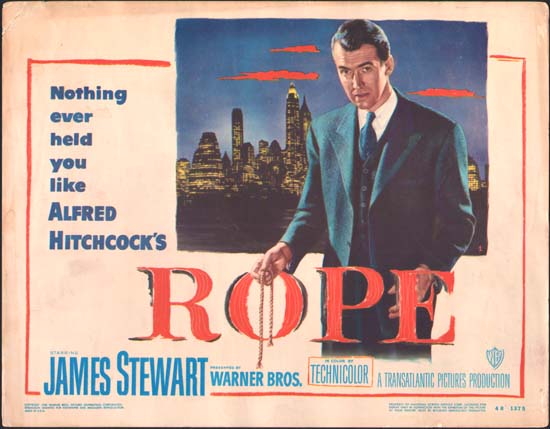 |
| Movie poster |
Rope is a thriller film directed by Alfred Hitchcock based on a novel of the same name written by Patrick Hamilton. The film stars John Dall as Brandon Shaw, Farley Granger as Phillip Morgan and James Stewart as Rupert Cadell. The film focuses on these two characters where they attempt to create “a perfect murder” whilst under their dinner guests’ noses. The film is notable for its use of long takes, appearing as a single continuous shot throughout the film.
 |
| (L-R) Phillip, Rupert and Brandon |
Without showing a different take or change of film, the camera goes into close up of objects, mainly character’s backs until the screen goes into black out before coming out of close up again with an overlay of the previous character’s dialogue used- creating “seamless” editing. The camera also at some stages creates and uses camera angles that the audience don’t usually expect to see. An example of this would be when Mrs. Wilson walks into the kitchen through the dining table, the audience expects a close up or some sort to show detail however Hitchcock suggests that having the film taken at long distance with the chest at the edge of the frame to create tension and mystery. “However, his obsession with telling a story without resorting to the usual methods of montage, and without cutting from one shot to another, results in a film of unusual, fascinating technical facility, whose chilliness almost perfectly suits the subject.” (Canby, 1984) This was made by having the set crew move the sets and props around and placing them back silentley whilst the camera moves around.
 |
| How the camera moves around set |
“The victim's scream brings us inside, and into Hitchcock's stylistic experiment. Brandon and Phillip throttle their friend and hide the body inside a living room chest and invite the dead man's friends and family to the party, with food served off the trunk-coffin, the kind of ghoulish touch that, according to Brandon, separates a "work of art" and a "masterpiece."” (Croce, 2006)
As with Hitchcock’s traditions of appearing in the films as cameos, Hitchcock appears in Rope as two cameos, one is of Hitchcock appearing as a man walking down the Manhattan street in the opening scene and the other is of his icon symbol on a red neon sign seen from the apartment window.
 |
| Hitchcock's appearence (in red neon icon) |
Hitchcock, A (1948) Movie poster (online):
http://www.movieposterstudio.com/detail.aspx?ItemNumber=1494 - (accessed on 6/02/2012)
Snow, R (2011) (L-R) Phillip, Rupert and Brandon (online):
http://robertsnow.wordpress.com/2011/08/ - (accessed on 6/02/2012)
Snow, R (2008) How the camera moves around set (online):
http://robertsnow.wordpress.com/2011/08/17/review-rope-1948/ - (accessed on 6/02/2012)
Hitchcock, A (1948) Hitchcock's appearence (in red neon icon) (online):
http://www.moviemail-online.co.uk/scripts/quiz.pl?ID=17 - (accessed on 6/02/2012)
Bibliography:
Crowther, B (1948) 'Rope': An Exercise in Suspense Directed by Alfred Hitchcock (online):
http://www.nytimes.com/library/film/081748hitch-rope-review.html - (accessed on 6/02/2012)
Canby, V (1984) 'Rope': A Stunt to Behold (online):
http://www.nytimes.com/library/film/060384hitch-rope-reflection.html - (accessed on 6/02/2012)
Croce, F.F (2006) Rope (online):
http://www.slantmagazine.com/dvd/review/rope/948 - (accessed on 6/02/2012)

No comments:
Post a Comment